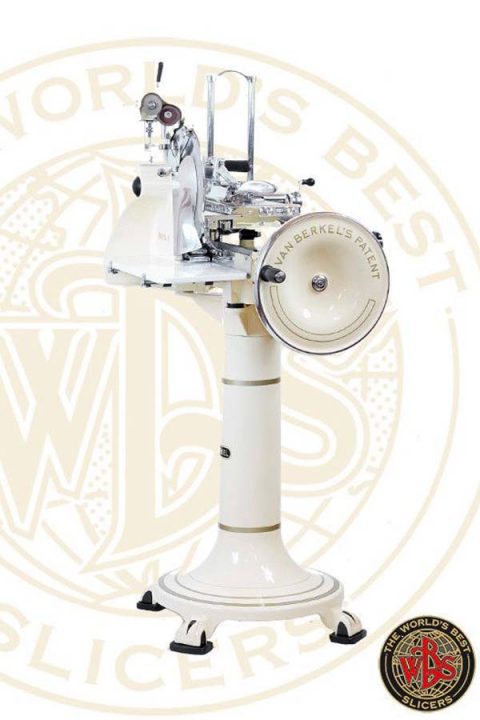Berkel Europe Model 20
The flywheel slicer model 20 was built in the factory of Van Berkel’s Patent Rotterdam Holland, in the period from 1928 to 1936. In the Berkel factories of La Porte in the state of Indiana, the U.S. Berkel model C
Berkel Europe Model 20
The flywheel slicer model 20 was built in the factory of Van Berkel's Patent Rotterdam Holland, in the period from 1928 to 1936. In the Berkel factories of La Porte in the state of Indiana, the U.S. Berkel model C and subsequently the U.S. Berkel model 11, both close relatives of the European Berkel model 20. The slicer has a double connecting rod system placed under the trolley that contributes to the movement of the balance that creates the displacement of the pawl on the toothed gear of the slice thickness. The worm screw is placed under the trolley in the front part of the flywheel, and the comb is fixed in the castell which slides on a pin fixed on the trolley. The cutting synchronism is regulated by a system fixed in the upper right part of the trolley, which allows to have depending on the version; 14 or 28, obtaining a thickness ranging from 0.27 mm. at 3.7 mm. The trolley moves on wheels guided by a rail present on the base. The trolley moves through three metal wheels guided by a rail present on the body of the machine. The connecting rod that imprints the movement of the trolley is synchronized with a second cam connecting rod located under the carriage itself. The displacement of the plate where the product to be cut is fixed in both directions, that is to say moving away and approaching, can take place through a lever placed on the right side of the trolley fixed to the center of the worm screw (fine adjustment), or by means of a lever placed in the center of the trolley (fast movement). The sharpener, with shape and mechanics entirely consistent with that of other models of the period is fixed on the shoulder, which changes shape depending on the period of production; the first version has the same shape as U.S. Berkel model C, while the second version is very similar to that of U.S. Berkel model 11. In the lower part of the shoulder is fixed the support plane produced in white opal, used for supporting the cut product. The blade used has a diameter of 370 mm. and in the lower part resting on the body of the machine there is the box for the collection of small pieces of cut product, to define a waste drawer. The Berkel flywheel slicer model 20 has a cutting capacity of 240 mm. in width 235 mm. in height 110 mm. in length. The slicer has a total size of 880 mm. in length, 650 mm. in width, 660 mm. in height. Requires a support of 500 mm. x 280 mm. The Berkel model 20 has a total weight of 98 kg. The slicer was supplied for direct support on work benches, but optionally its original Berkel pedestal was sold.The restoration is carried out in the laboratories of "The World's Best Slicers" respecting the principle of conservation of the parts. Providing for the disassembly and recovery without any replacement of the worn or broken pieces, carrying out a carryover of material by welding and subsequent milling or turning of the pieces in order to bring them back to their original dimensions and their functionality. For the missing parts, original spare parts acquired from the production plants or incomplete slicers are used. The painted parts, which were first stripped by cryo-stripping and carefully prepared, are painted using new generation paints that comply with health and pollution regulations and reformulated in the correct shade of color used in the past. The decorations are strictly performed through the application of copal paint decals, avoiding any type of mystification, such as airbrush decorations, stickers or any other type of fantasy decoration. Each restored slicer is delivered with an Official Certificate of Originality and Guarantee


























